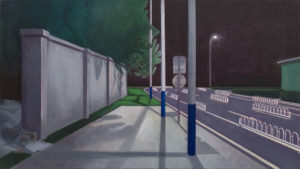The ambiguous presence of the body in dreams and the uncertain status of our dream “double” when we are sure of living on the skin our night visions are themes that have fascinated generations of artists and that the new illusive possibilities and the immersive vocation of graphics digital have reportedly in vogue. Does our body still exist when we fall asleep? How can we reconcile the person known as “I” in our mind and dreams, with our body in flesh and blood? These are the questions at the center of Cloud of the Unknown, Gao Yuan‘s new animation (still work in progress). The artist (b. Kunming, Yunnan, China, 1986), who in 2009 graduated in Animation Arts at the Communication University of China (Beijing), in her hybrid animation and painting work and personally deals with all the stages of the process of making her films, such as writing the screenplay, drawing the storyboard, painting the scenes, animating and editing in post-production. This long gestation runs counter to the industrialization of traditional animation productions (the realization of her previous work, Lunar Dial, lasted six years) and allows her an otherwise impossible freedom of expression, especially in a totalitarian nation as China is.
Cloud of the Unknown is composed of individually painted frames, in which over time the artist’s experiences stratify, making each of them a vast repository for everything that has grown inside. This film starts from a hypothesis, originating from a real sensation experienced by Gao Yuan: “once I felt the sensation immediately before falling asleep still vivid, as if my whole body had evaporated in an instant.” The animation provides a perfect tool to visualize an intermediate limbo between dream and reality, endorsing the hypothesis that film and dream can be the same thing, as it would also be confirmed by the fact that a complete sleep cycle lasts 90 minutes, just like a normal film. This is why in Cloud of the Unknown it is perceived as a lucid dream, in which the dreamers are aware that they are dreaming, with their consciousness lingering between dream and reality. The parallelism between the dream and the real dimension is accentuated by the settings, alternately based on recognizable landscapes really visited by the artist and surreal montages of illogical elements.
In Losing Sight (2018) we recognize, for example, a bird’s eye view of a residential area of Shanghai, in Street at Night (2017) a melancholy night cityscape in Beijing, a dilapidated forgotten industrial suburb, but also in the Shengsi Islands the lush nature of the archipelago located south of the mouth of the Yangtze River in China. Next to these real landscapes, to which, however, the fact of being artificially deserted gives a disturbing estrangemen,t we find montages of bizarre settings and symbols: a violin with broken strings, a room on fire, infinite stairs or a pair of hands flying between thorns and bushes. These sets are the scenarios in which the protagonist’s adventures happen, a lonely girl different from the others who in an accident meets a woman as lonely as she is who will help her to know herself again. The appearance of the protagonist is that of her life partner Anita Pan, composer, sound technician and in Cloud of the Unknown also an actress, a circumstance that introduces another important aspect of the artist’s biography that pours into her work.
If the practice of Gao Yuan investigates the uncertainty of consciousness and the nebulous twilight of the dream, the artist from a programmatic and ideological point of view has very clear ideas, as it can be understood from a video recently released as if it were a personal manifesto, recently released by the Capsule Shanghai gallery that represents her. In this short statement, accompanied by the images of her work in which we see very clearly the symbiosis between traditional painting techniques and digital post production, she states: “Painting is the most age-old art and film the most versatile. When the two works together, you will see something really marvellous as a result. The art of animation involves painting static frames that can ony be completed through repeated observation and polishing and putting these frames into a consistent streaming of time allowing them to be fleeting. (…) There’s several parallel worlds that coexist in Cloud of the Unknown, and the tecniques to present them are different. I’m hoping to reveal a universe as rich as possible. Although it might be a mere illusion, its richness alone is worth people feeling, exploring, and loving each other in it. This is the first time I wrote my own script. The making of this animation requires a lot of labour work. However, films that concern homosexual romance are not allowed to be screened in China, so it’s very difficult to find production and financial support within the country. Despite this situation, I have no intention of changing anything I wanted to express. I used to believe that everyone has the right to express freely, butnow I’ve realised that free expression is not only a right but it’s also an obligation”.
Info:
 Gao Yuan, Blue Light, acrylic on canvas, 2019
Gao Yuan, Blue Light, acrylic on canvas, 2019
 Gao Yuan, Coma, acrylic on canvas, 2020
Gao Yuan, Coma, acrylic on canvas, 2020
 Gao Yuan, Wukang Road, acrylic on canvas, 2020
Gao Yuan, Wukang Road, acrylic on canvas, 2020
 Gao Yuan, Street at Night, acrylic on canvas, 2018
Gao Yuan, Street at Night, acrylic on canvas, 2018
 Gao Yuan, Under the Light, acrylic on canvas, 2019
Gao Yuan, Under the Light, acrylic on canvas, 2019

Art is made to disturb, science to reassure.
(Salvador Dalì)






NO COMMENT